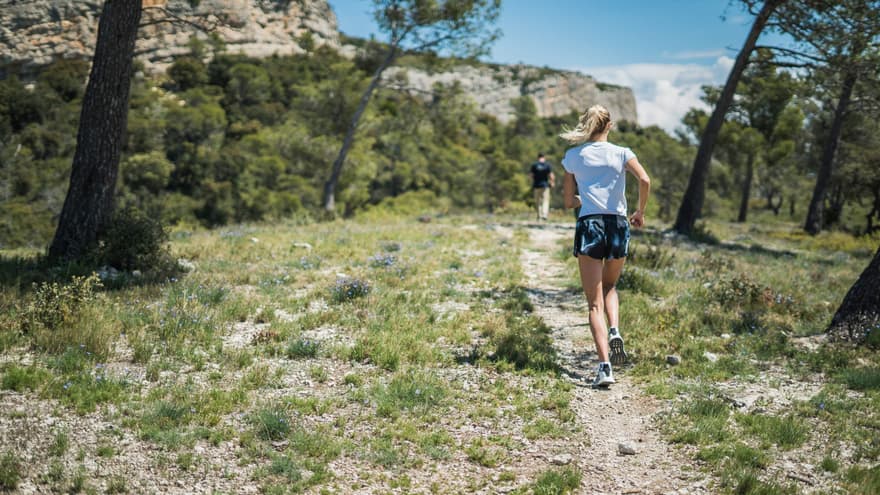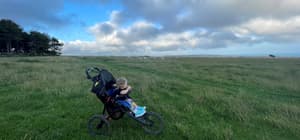29 September, 2023
Beginning with trail running is as challenging as it sounds, but all the adventure is worth taking because the joy and thrill it brings are unmatched.


Trail running is full of temptations at every corner of the hill. Whether you are new to it or a seasonal runner, you don’t need a lot of gear but a comfortable tracksuit and a pair of shoes to run. If you are still bewildered about how to start, continue reading our best trail running tips for beginners.
1. Pick the right trail for running
Whether shifting from road running to trail running or looking for the right trail, choose wisely. You might be fond of going around the mountains or love coastlines, but there may be more options around your city. You can start in many ways, like a local outdoor adventure shop, which can navigate you through the nearest available and running-friendly trails. Or visit online pages like Trail Run Project, RunGo, MapMyRun, AllTrails, Roots Rated, or ViewRanger.
2. No two trails are the same
No two trails are going to be alike. Some may be like flat terrain; some are bushy and have rocks, thrones, or a muddy way to the top. Be ready for the obstacles a trail may contain, like a steep climb or a speedy descent. No matter if your trail this time is leisurely or arduous, what remains constant is you can see wildflower meadows, a scrumptious waterfall, changing weather, or sometimes wildlife.
3. Wear the right trail running shoes
Trail running shoe is the first and foremost important gear to make your trail run a successful voyage. If, luckily, you hit the gravel and balanced surface, your road run shoe will serve the purpose; however, if your trip encounters a rock, slippery mud, or roots, your shoes need to have better traction than conventional road running shoes. According to your comfort, they can either be stripped down or accustomed to more cushioning to support the joints.
4. Take the right accessories with you
A few accessories you must keep in your backpack are a torch light with a minimum output of 200 lumens; a headlamp can sometimes be enough. In both ways, light is necessary for nighttime tracking or near sundown to avoid mishaps. Other than that, keep sunscreen lotion (SPF 30 or above), energy-booster food, and a water bottle. Keep rehydrating your body when needed to prevent dehydration. The inclusion of the first aid kit depends greatly on the duration and location of a trail. Suppose it is near civilization and for a short span. In that case, basic first aid items like bandages will work fine, or if it is in a remote area and for more time, then anti-bacterial and analgesics, water treatment tablets, athletic tape, blister bandages, and even, in some cases, emergency shelter would be required.
5. Bringing a watch and navigation tool is mandatory
Prevention is better than cure; even if you are not far from the social settings, keeping a watch with some navigation help is a good idea. Some watches are basic that tell the time and have a stopwatch. Others are more professional with GPS trackers to count on the distance and speed and a location locator. Some can even check heart rate, which is particularly helpful for heart patients.
6. Chose Clothing wisely
Clothing should be according to the demand of the weather and must be breathable. A merino wool and a synthetic fabric would work fine. A rain-protective overcoat, a windbreaker for the rainy season, and a windy environment will be your best track help. Clothing in layers is advisable, too, for changing body temperature demands—the zippered neck and a lightweight, soft shell fabric work great under the sun.
7. Be ready for the transition trail techniques
Every trail has unique demands while you unravel the route; changing technique for the uneven terrain from the paved surfaces will keep you on the track much more easily and for a longer time.
For hill climbing, take shorter strides, especially for steep areas, and keep your back straight, feet underneath, and eyes on the track to scan for the obstacles. Going downhill, protect your back and avoid potential injury by leaning back. For the flat way, walk or run with short strides and eyes ahead of you, and look at least 10 to 15 feet further. Swing arms to keep the balance, walk when required, and take the route not liable to stumble or fall anyway.
8. Select the right time to run
Trail running is an addiction, and some might get tempted by it more than others. Nevertheless, taking necessary breaks is discerning when to run and when to stop. These are called strategic breaks and not rest. Give sufficient time for the body to recover completely, especially for long runs, and continue as soon as possible. Also, be mindful of staying within a reasonable distance on track. Take familiar routes before you become accustomed to the trail running.
Trail running is advantageous over road running as it is away from pollution and a nature therapy equally favorable for young and older adults. Selecting the right location and bringing the relevant accessories makes the journey easy. Always wear clothing in layers, keep a water bottle for rehydration, and wear a watch, preferably with navigation help. However, tracking techniques need practice and exposure. Keep trail-running and learning new techniques, challenge yourself, and upgrade your stamina and form simultaneously.

Ever fancied trying cross country running? Do you really even know what is it? Take a deep dive into this section of running and find out if it might be for you.

Not everyone knows what they should really be eating that will help them quickly refuel again and also promote their recovery, especially after a run in ‘rugby weather’ and the earlier darker evenings.
Tasha from Black Girls Do Run UK is giving us some top tips on how to find a running club

Like a performance sports car, there are essential fuels every runner requires

Wanting to get out running with your toddler in a buggy, but not sure where to start? Read our top tips to help you both get the most out of the fun sport that is buggy running.

Running any ultra marathon is an experience, but running your first one takes you through a whole new set of emotions and pain. Take a look at Dom's vlog where he attempted to run the Glasgow 2 Edinburgh 50 mile event.